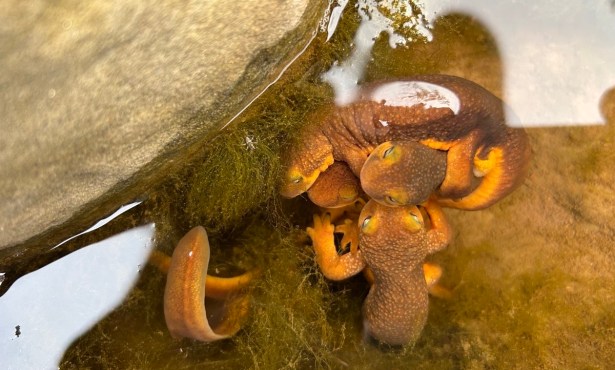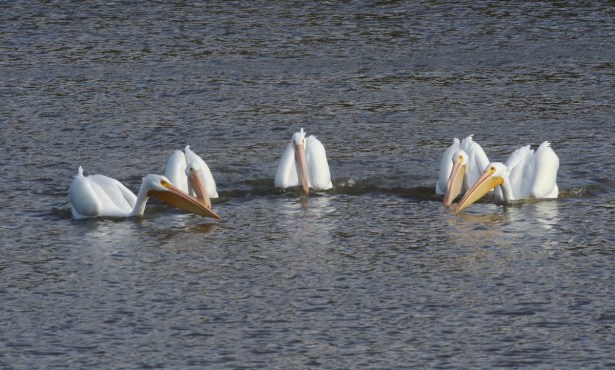Saving the California Condor from the Brink of Extinction
S.B. Zoo Director of Conservation and Research Dr. Estelle Sandhaus Discusses California Condors and Conservation Efforts Ahead of Wild Talks Lecture

California condors have distinct personalities: one of the many things Dr. Estelle Sandhaus, director of conservation and research at the Santa Barbara Zoo, finds fascinating about the gentle giants.
“When they fly over you, your heart is racing; you can hear the wind in their primary feathers,” she described. “They’re just so enormous.”
Sandhaus helped develop the protocol and trained community volunteers and staff for a “nest watching” program, a significant factor in the conservation of critically endangered California condors. She will discuss her work in-depth during the Santa Barbara Wildlife Care Network’s “Wild Talks” lecture on Wednesday, August 30.
“We live in a biodiversity hotspot, so we feel a great responsibility to the species in our backyard,” said Sandhaus.
Although conservationists don’t know how many California condors made up historic populations, declines were evident during European colonization of their habitat (history’s common harbinger of bad things, in general). However, it wasn’t until the 1980s that the birds suffered a dramatic decline. At one point, the world population totaled just 22 animals.
“That’s a population on the brink of extinction,” Sandhaus explained. “When it gets that low, biologists aren’t even certain if you can get them back.”
The consensus is that the driver of that decline was lead poisoning. Condors are scavengers, she said, meaning they almost exclusively eat dead things.
When people shoot animals with lead ammunition, the lead can fragment into tiny, tiny pieces, distributing what looks like a blizzard of little metal particles along the gun wound and beyond.
“What happens is scavengers — not only condors, but bald eagles, mountain lions, anything that feeds on carcasses or gut piles of animals left in fields — inadvertently ingest those lead particles,” Sandhaus said.
For condor populations, though, it’s especially lethal. They’re a social species that often feed together in groups, so there is greater potential for poisoning a high portion of the population from just one lead bullet. Sandhaus explained, “At one time, you can have as many as 50 birds eating the same carcass.”
Captive breeding, beginning in 1987, was seen as the only option for preserving genetic diversity and bolstering the birds’ numbers for later reintroduction. Although biologists weren’t sure if it could even be done, the Los Angeles and San Diego zoos spearheaded captive breeding efforts.
Miraculously, the condors — native to the western United States and Baja, Mexico — made a comeback. Since then, a number of reintroduction sites have been established in California and other areas of the southwestern U.S. and Mexico.
“As of December 2022, the total world population of condors was 561, and 347 of those were flying free,” Sandhaus said. “It’s a huge success story.”

Following their heroic comeback, however, the condor still faces barriers to full recovery — critical habitat is still vulnerable to human impacts, and lead poisoning from ingesting ammunition has remained the number one mortality factor for wild flocks.
“Lead is still out there, and it is still killing birds,” Sandhaus said. “We’re working closely with the community to reduce lead in the environment.”
Responsible hunters who use alternative ammunition, such as copper, can actually increase the availability of clean food for condors. “So it’s really just about getting the lead out,” Sandhaus said.
In the first five years of reintroduction, only two chicks in Southern California fledged (left the nest), and it was due to aggressive nest management, such as removing trash and even airlifting one bird to the Los Angeles Zoo for surgery. The main factor in nest failure in those early years, Sandhaus explained, was parents feeding small items of trash to their chicks — tabs from soda cans, bottle caps, and shards of glass, mistaking them for natural dietary items such as bone shards.
“That’s where we started doing a lot of nest management,” she continued. “The zoo has biologists out in the field every day tracking condors alongside our fish and wildlife colleagues.”
Sign up for Indy Today to receive fresh news from Independent.com, in your inbox, every morning.
Over time, nest guarding became more successful, and trash has become less of a problem due to clean-ups and other factors. They went from as little as 6-12 percent nest success to maintaining over 50 percent nest success for more than a decade.
“Some of the nests that are more remote and less managed also seem to be approaching the success of more managed nests,” Sandhaus added. “So we’ve been doing a little bit less management — taking the training wheels off, just to see how they do.”
Santa Barbara Zoo biologists work with different wild flocks, but primarily the Southern California flock, to assist their partners in managing reintroduced populations, such as releasing birds reared in zoos and tagging condor chicks.
However, the condors that visitors see at the Santa Barbara Zoo are limited to those not viable for release, since they experience so much direct human contact. Some of them were injured in the wild — such as one chick with a wing injury that hindered its ability to forage on its own — and some are adolescents who are genetically slated for the captive breeding program but haven’t yet reached sexual maturity.
“We rear them here, and then they go onto one of the breeding centers,” Sandhaus said. “Until then, though, people can see and learn more about them.”
Some condors at the zoo are bold, some are more timid, and some are curious. “They all have their own personalities,” Sandhaus said. “I would say probably every biologist secretly has some favorite birds.”
In addition to their colorful personalities, Sandhaus is especially fascinated by their family life. “They’re incredibly attentive parents; they spend so much time with their chicks,” she said, adding that parents, like humans, must teach their youngsters how to “behave respectfully.”
In the early years of releases, young, captive-bred birds were sometimes beaten up a little bit for being too bold at feeding sites. They weren’t yielding to adults, as they would have been taught to do by parents in the wild.
“The folks rearing the birds had to change their rearing techniques to ensure that the young condors went into the wild understanding hierarchy,” Sandhaus said. “It’s just fascinating to watch.”
In addition, condor parents form heartwarming, long-term bonds with their mates.
But now that researchers can do genetic testing of offspring, they’re finding — like many other species that were long thought to be monogamous — that there is some “extra pair copulation going on.”
“It starts to look a little bit like a soap opera out there. You have competition for popular individuals,” Sandhaus added. “It’s funny to see, like, you never know what’s going to happen.”
However, they are unsure if they’re observing the same level of extra-pair activity they might have seen in a healthy population. Since they’re losing adults to lead poisoning, there may be more shifting of mates due to less stability, though Sandhaus thinks that some level of extramarital affairs, so to speak, was always happening.
Another exciting thing about the birds is their incredible memory. “There was this one bird; his name is Hoi, a Chumash name,” she shared. “I believe he had been one of the original wild condors, and he was part of the captive breeding program for about 30 years.”
Once Hoi was genetically well-represented, they made the decision to release him back to the wild. Somehow, he was able to navigate his way back to where he hatched. “30 years later, he returned to his old neighborhood,” Sandhaus said. “It’s just nuts. Like, I went to grad school in Atlanta, and I was gone for three years. And I visited again, and I couldn’t even remember where to drive, you know?”
During the August 30 lecture, Sandhaus will further discuss nesting and nest management. “It’s very preliminary, but we think we may be seeing some early nest failure that we hadn’t seen before in the Southern California population,” she said.
“It speaks to the importance of the intensive monitoring we’re doing of this population that is still working toward recovery. Basically, we’ve been stepping up our monitoring of that early egg phase to see how that shakes out.”
Attendees will also hear from Debbie Parisi, Board Member of Friends of California Condors, Wild and Free, and Arianna Punzalan, the Supervisory Wildlife Biologist at the Hopper Mountain National Wildlife Refuge Complex for U.S. Fish and Wildlife.
“Our lecture will review the history of the California condor and what led to its endangered status,” Parsi said. “We will also talk about the California Condor Recovery Program and how it works with its partners, including the S.B. Zoo and USFWS, we are ‘Saving the California Condors.’” The talk will be held at the Museum of Natural History Fleischmann Auditorium from 6-7:15 p.m. on August 30. It will be preceded by an Information Fair and Market at 5 p.m. and followed by a reception. Tickets can be purchased through the Wildlife Care Network: sbwcn.org/events/wild-talks-condors




You must be logged in to post a comment.